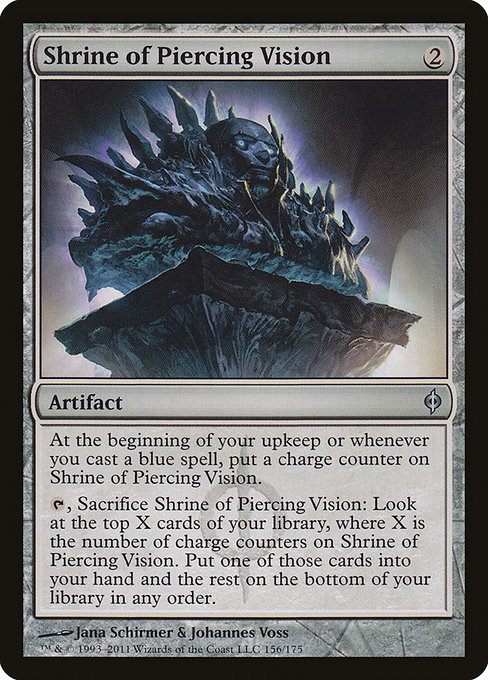
Image courtesy of Scryfall.com
Humor, Upkeep, and Endless Possibilities: Shrine of Piercing Vision in Modern Strategy
Among the many quirky artifacts Wizards has sprinkled through MTG’s history, Shrine of Piercing Vision stands out as a tiny laboratory for player innovation. A colorless New Phyrexia oddity with a deceptively straightforward cost of {2}, it thrives on the metagame’s rhythms: upkeep triggers, blue spells, and a ritualized gain of knowledge. The creativity it invites isn’t flashy like a tier-0 combo card; instead, it rewards long, patient planning and a willingness to embrace constraint as a feature rather than a bug 🧙♂️🔥. You don’t win Shrine games with one big swing; you win by stacking modest climbs in information, one counter at a time, until the top of your library becomes a map of choices rather than a decklist you memorize at home.
In the New Phyrexia era—where gleaming black borders and silvered machinery evoke a strange, cold elegance—the Shrine sits at the crossroads of resource tracking and card selection. Its oracle text is elegant in its efficiency: at the start of your upkeep and whenever you cast a blue spell, you accumulate a charge counter. Then, by paying {T} and sacrificing the shrine, you examine the top X cards of your library, where X equals the number of charge counters, pick one to draw, and put the rest on the bottom in any order. It’s not a straight tutor; think of it as a choice-forward lens that nudges you toward deliberate curations rather than random draws 🧭🎲.
Flavor-wise, the artifact’s Phyrexian watermark and the clockwork vibe of New Phyrexia mirror the mental clock you’re dialing in as you experiment with this constraint-driven approach. The card’s rarity—uncommon—plus its dual foil and nonfoil finishes, and the fact that it’s a colorless engine, invites a certain playful curiosity in players building artifact- or colorless-heavy lists. You’re not just playing to win; you’re playing to illustrate a principle: constraints can be fertile ground for invention. The art by Jana Schirmer and Johannes Voss reinforces that vibe with sharp lines and metallic glow, a reminder that even in a harsh, machine-stitched world, imagination can find a way to gleam 💎⚙️.
“If the top of your library is a map, Shrine of Piercing Vision is the compass you borrow from a wizard’s hat—slightly ridiculous, incredibly precise, and always pointing toward discovery.”
So how does one actually weave this into a deck and a game plan without turning your playgroup into a math class? Start with the core constraint: every blue spell you cast nudges the Shrine toward more counters. That means you’ll want a steady supply of blue spells—think cantrips, mollified fissures of control, or selection tools—that don’t just win you the race but also feed the Shrine’s appetite for counter accumulation. The trick isn’t to cram blue cards in; it’s to design a cadence where each spell serves dual purposes: advancing your control plan while inching the shrine toward “X” that unlocks your most flavorful draws. The more counters you accumulate, the deeper your top-of-library glimpse becomes, and the more dramatic your one-card choice can feel. It’s a ritual of patience, a guided exploration that rewards those who enjoy chess with their deckbuilding ♟️🧙♂️.
In practical terms, Shrine of Piercing Vision can slot into several archetypes. A blue-centric control shell can leverage the shrine as a late-game engine, turning a handful of high-impact blue spells into a gradually expanding library of options. Alternatively, a colorless artifact-themed deck—leaning on cards that enhance artifacts or that benefit from repeated draw and filter effects—can use the shrine as a quiet, evergreen engine. You’re not always “going off” in a single turn; you’re constructing a narrative where your library’s top is a running commentary on what your opponent can anticipate and what you can improvise. The ritualistic feel fits nicely with slower formats like Commander, where long games reward incremental advantage and where your table will appreciate the humor of gradually uncovering a winning line through disciplined reveals and careful ordering ⚔️🎨.
Humor, in this context, isn’t about jokes at a table—it’s about embracing playful constraints that sharpen decision-making. For example, you might adopt a self-imposed rule: only the top X cards can be added to your hand via Shrine, with X growing as you add more charge counters. If your goal is a clever puzzle rather than a fast kill, you’ll find satisfaction in engineering a path where the most important card is often the one you reveal, not the one you draw first. And because the Shrine is a colorless artifact, you can pair it with a broad spectrum of support cards—from Tezzeret-style artifact tutors to draw-speeds that don’t disrupt your sacred counting ritual. The synergy is a reminder that MTG thrives on constraints that spark creativity, not inhibit it 🧩🪄.
Beyond gameplay, Shrine of Piercing Vision fits neatly into the broader MTG memory lane: it’s a reminder of the joy of niche knowledge and the thrill of turning a modest effect into a strategic cornerstone. It’s also a cute nod to the hobby’s do-it-yourself spirit—much like selecting a rugged phone case that keeps your device safe in the heat of a rush to the finish line, Shrine encourages you to protect your plan while you push the envelope. If you’re looking to keep your tech safe while you plan your next big play, consider checking out the Rugged Phone Case — Impact Resistant Glossy Finish, a practical companion for long nights of drafting and deck tinkering 🔥💎🎲.
For readers who want to explore more of the network’s MTG-minded conversations, here are five curated reads that echo the spirit of inventive play and measured risk (and yes, they’re all worth a click):
More from our network
- https://blog.digital-vault.xyz/blog/post/deep-slumber-titan-planeswalker-cameos-across-the-multiverse/
- https://blog.digital-vault.xyz/blog/post/unlock-youtube-monetization-proven-marketing-strategies/
- https://blog.digital-vault.xyz/blog/post/cloudhoof-kirin-mana-costs-revealed-by-machine-learning-clustering/
- https://transparent-paper.shop/blog/post/seamless-ai-chatbot-integration-for-marketing-campaigns/
- https://blog.digital-vault.xyz/blog/post/haunted-house-mastering-randomness-and-skill-in-mtg/